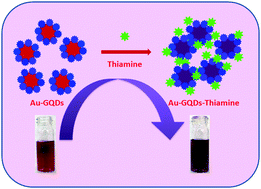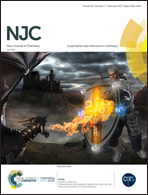Highly selective naked eye detection of vitamin B1 in the presence of other vitamins using graphene quantum dots capped gold nanoparticles†
Abstract
The present study describes the synthesis of gold nanoparticles capped with GQDs (Au-GQDs) at room temperature and their application towards selective and sensitive sensing of thiamine by colorimetry. The GQDs were prepared from citric acid by pyrolysis at 200 °C and used as capping and reducing agents for the synthesis of AuNPs at room temperature. The TEM studies revealed the size of the Au-GQDs as ∼7.7 nm. The GQDs show strong blue luminescence when excited at 365 nm due to the presence of surface oxygen functional groups. However, the emission intensity of the GQD capped AuNPs was drastically decreased due to the involvement of hydroxyl functional groups for the reduction of Au3+ to Au0 besides the occupation of Au0 on the surfaces. The synthesised Au-GQDs were used for the colorimetric and spectrophotometric determination of thiamine. The addition of 160 × 10−9 g mL−1 thiamine changes the color of the Au-GQDs from wine red to violet. Interestingly, the addition of other vitamins to the Au-GQDs does not bring any obvious colour change. This is mainly due to the electrostatic interaction between the functional groups of the Au-GQDs and positively charged thiamine. Furthermore, the practical application of the present method was demonstrated by determining thiamine in blood samples.



 Please wait while we load your content...
Please wait while we load your content...